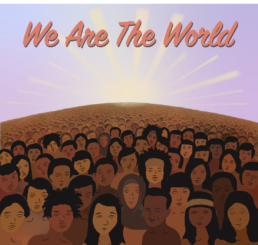
Climate shocks: a test of resilience
East Africa is currently facing a severe drought that threatens the food security of 13 to 15 million people in Ethiopia, Kenya, and Somalia. The United Nations Office for the Coordination of Humanitarian Affairs (UNOCHA) estimates that 5 million children face malnourishment in the region, urging for a region-wide resiliencebuilding effort. In addition to variable rain patterns that lower agricultural productivity, resulting in crop failure, East Africa experienced dessert locust attacks which, according to FAO, are the worst seen in 25 years for both Ethiopia and Somalia, and the worst outbreak for Kenya and Uganda in 70 and 60 years respectively. Considered the most destructive migratory pest, a single square kilometer of a desert locust swarm consumes the equivalent of what 35,000 people consume in a day.
Severe, and prolonged drought is not the only climate-related disaster plaguing the region. In addition to the extreme effects of climate change, the Coronavirus pandemic has severely diminished the productivity of economies in the region, that struggle to formulate effective mitigation measures. The World Health Organization (WHO) official figures show that Eastern African countries, like the majority of Africa, have vaccinated less than a percent of their respective populations. East Africa stands to suffer the most from further infection waves given its other vulnerabilities: climate-related crises, conflict, inflation, and disruption to global supply chains.

Multiple failed attempts to bring the conflict to a decisive stop have only resulted in a spill-off of conflict into the neighboring Afar and Amhara regions.
The Ethiopian economy suffered immensely, particularly given that conflict erupted amid recurrent desert locust attacks in Tigray and parts of Amhara region. The harvest season was also preceded by the onset of conflict which severely disrupted agricultural productivity. After a concerted international pressure campaign on Ethiopia’s Federal Government to cease operations in Tigray for humanitarian reasons, the Federal Government succumbed to these pressures, stating that a pause in hostilities will primarily allow the resumption of agricultural activities in Tigray- Ethiopia’s most food-insecure region. Multiple failed attempts to bring the conflict to a decisive stop have only resulted in a spill-off of conflict into the neighboring Afar and Amhara regions. Relatedly, Ethiopia, like others in the region, risks crippling Western sanctions that would further exacerbate food insecurity. Loss of life and destruction of public infrastructure characterized Ethiopia’s conflict in the north; figures from independent groups show the economic cost of the war to be upwards of $2.5 billion. Ethio-Telecom, the nation’s largest telecommunications provider, reports losing $74 million in half a year as a result of the conflict.
Global supply chain shocks
According to the Pan African Chamber of Commerce, the Ukraine-Russia war primarily affects the African wheat, fertilizer, oilseeds, and petroleum commodity markets (PAC/ UKR/ IMPC/2022). The report forwards that 32.5% of Africa’s wheat imports originate in Russia, and 32.3% is sourced from Ukraine. The UkraineRussia war is expected to send shockwaves, particularly in the Horn where Ethiopia and Kenya source up to 40% of their wheat imports from both Russia and Ukraine. Djibouti stands to suffer the worst given that nearly 90% of its wheat import is sourced from Russia and Ukraine. Fertilizer prices, expected to increase alongside petroleum gas price increases, are also expected to spike not only because Russia is the world’s largest exporter, but also due to related sanctions in other Eastern European states. It is worth noting that, given the extreme polarization in the international arena, African nations are likely to face economic arm-twisting by trading partners. The PACC, however, points to new opportunities for inter-Africa trade to offset the effects of a global supply chain disruption.

Regional level resiliencebuilding
African governments should endeavor to implement regional early-warning mechanisms to collaboratively prepare for climate-related disasters. The Intergovernmental Authority on Development (IGAD) accurately predicted drought across multiple East African countries in the first half of 2022, emphasizing the need for a swift intervention at the household level, as well as increased collaboration for better resilience against food insecurity. IGAD reports that due to a coordinated multi-agency effort, a loss of $1.3 billion in cereals to desert locusts was averted— meeting the cereal requirement of nearly 30 million people. The Famine Early Warning Systems Network (FEWS Net) also recommends an inter-agency and multistakeholder approach to mitigating drought in the region. In addition, FEWS Net warns that food insecurity in Ethiopia, the most populous country in the region, will likely prolong conflict conditions in the North and further imperil the population.
Somalia’s recently held elections, which were delayed by more than a year, show encouraging signs of political stability in the face of internal security threats and severe climate shocks.
FEWS Net reports that between October and December of 2021, the was a failure of rainfall across most of Somalia, as well as southern Ethiopia and eastern Kenya, making it the third consecutive year of below-average rainfall. As food security is directly tied to conflict, the region’s leaders must shift focus away from conflict rhetoric to that of resilience building in the face of an impending food crisis. Somalia’s recently held elections, which were delayed by more than a year, show encouraging signs of political stability in the face of internal security threats and severe climate shocks.
Neighboring Kenya is making preparations to hold general elections in August of 2022 while Ethiopia prepares for a national dialogue to address longstanding grievances of the various ethnic groups that make up the country. Ambassador Redwan Hussein, State Minister at the Ethiopian Ministry of Foreign Affairs and Spokesperson for the State of Emergency Taskforce, noted that an all-encompassing national dialogue is long-overdue to finally lay to rest issues of land, identity, and transitional justice. In addition, Ethiopia’s leaders face the daunting task of post-conflict economic reconstruction, at the minimum, in the regions that now experience relative peace. The Ethiopian government, however, is yet to propose an effective way to end the stalemate with Tigray and prevent a relapse into conflict.